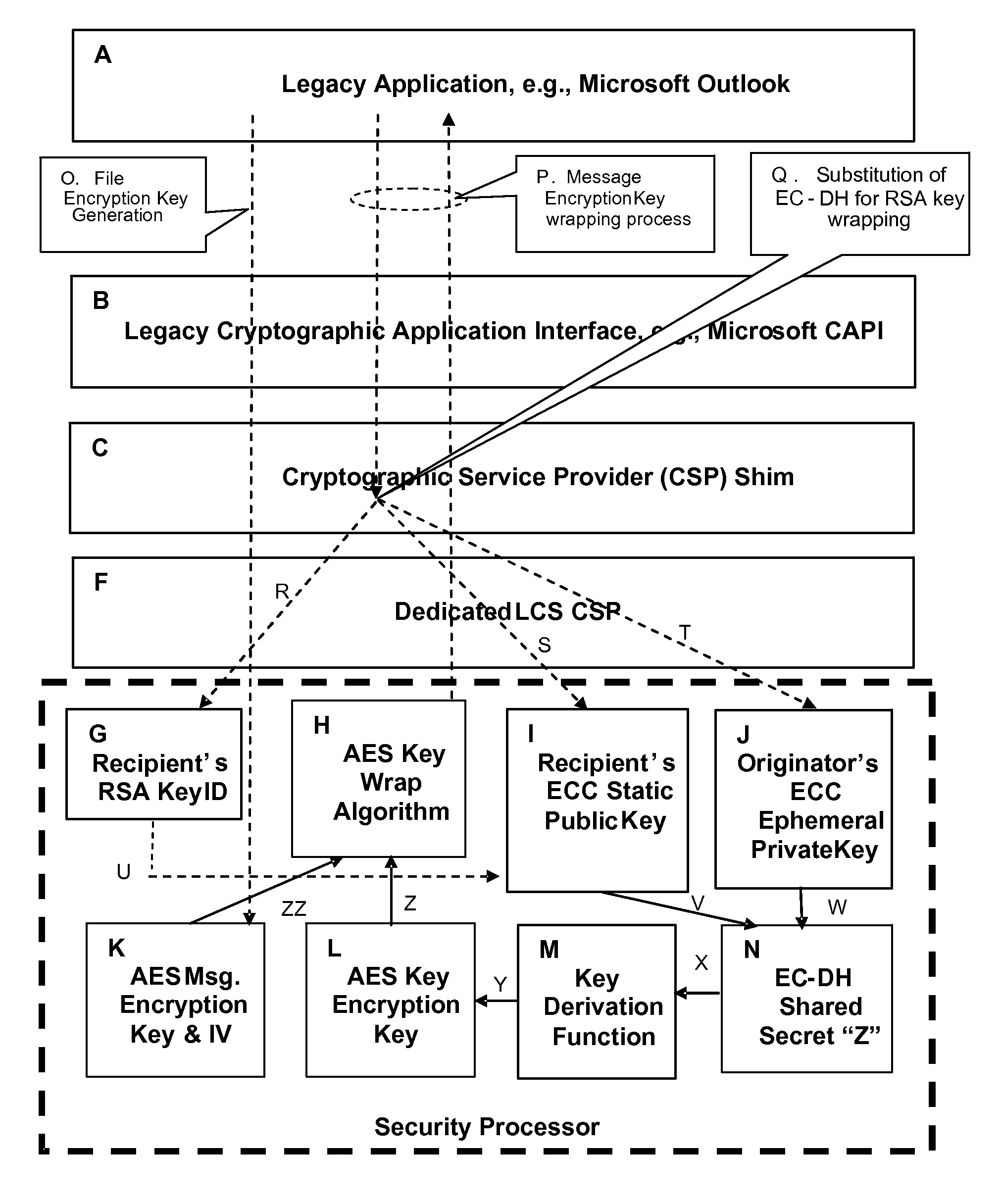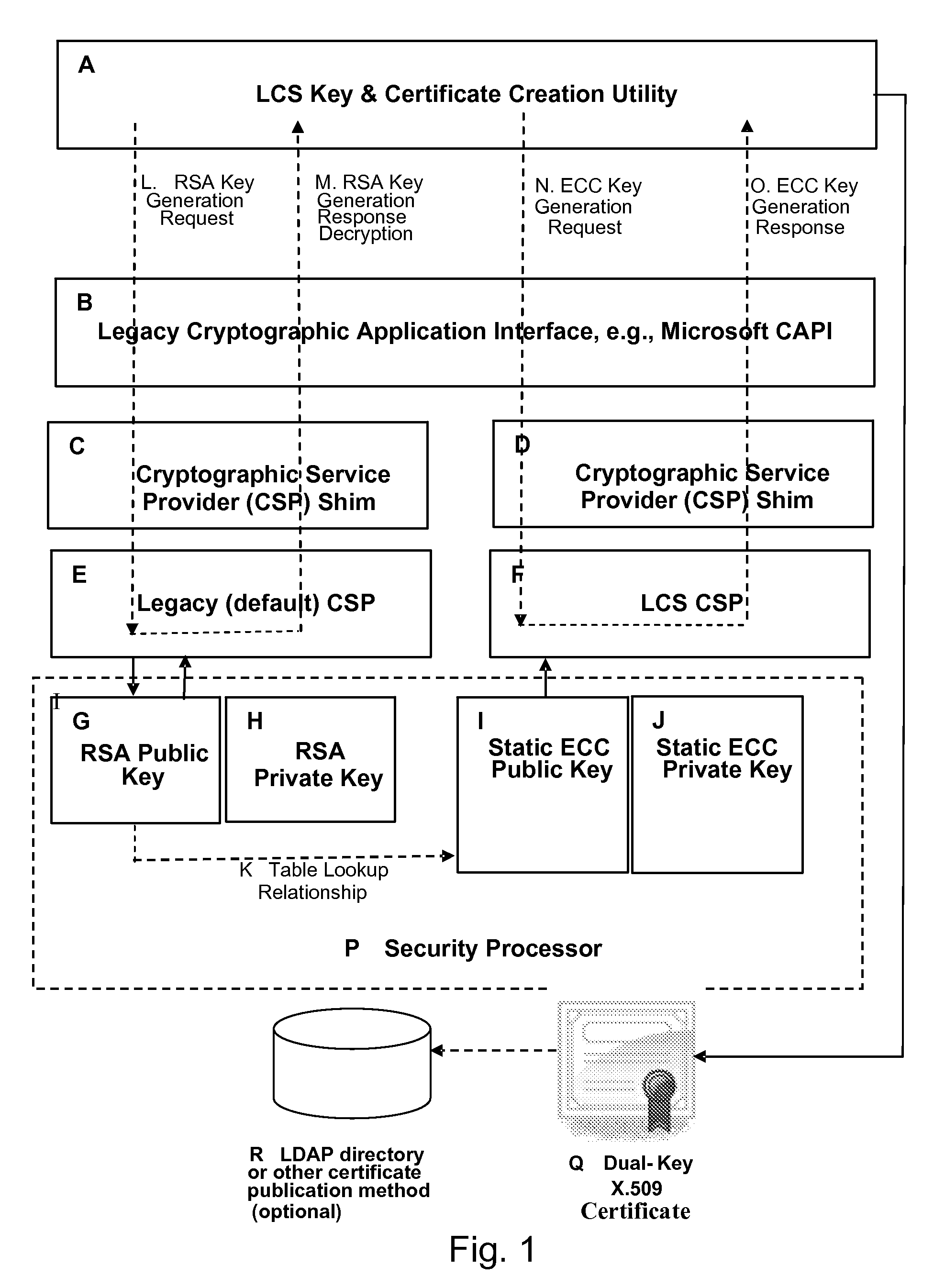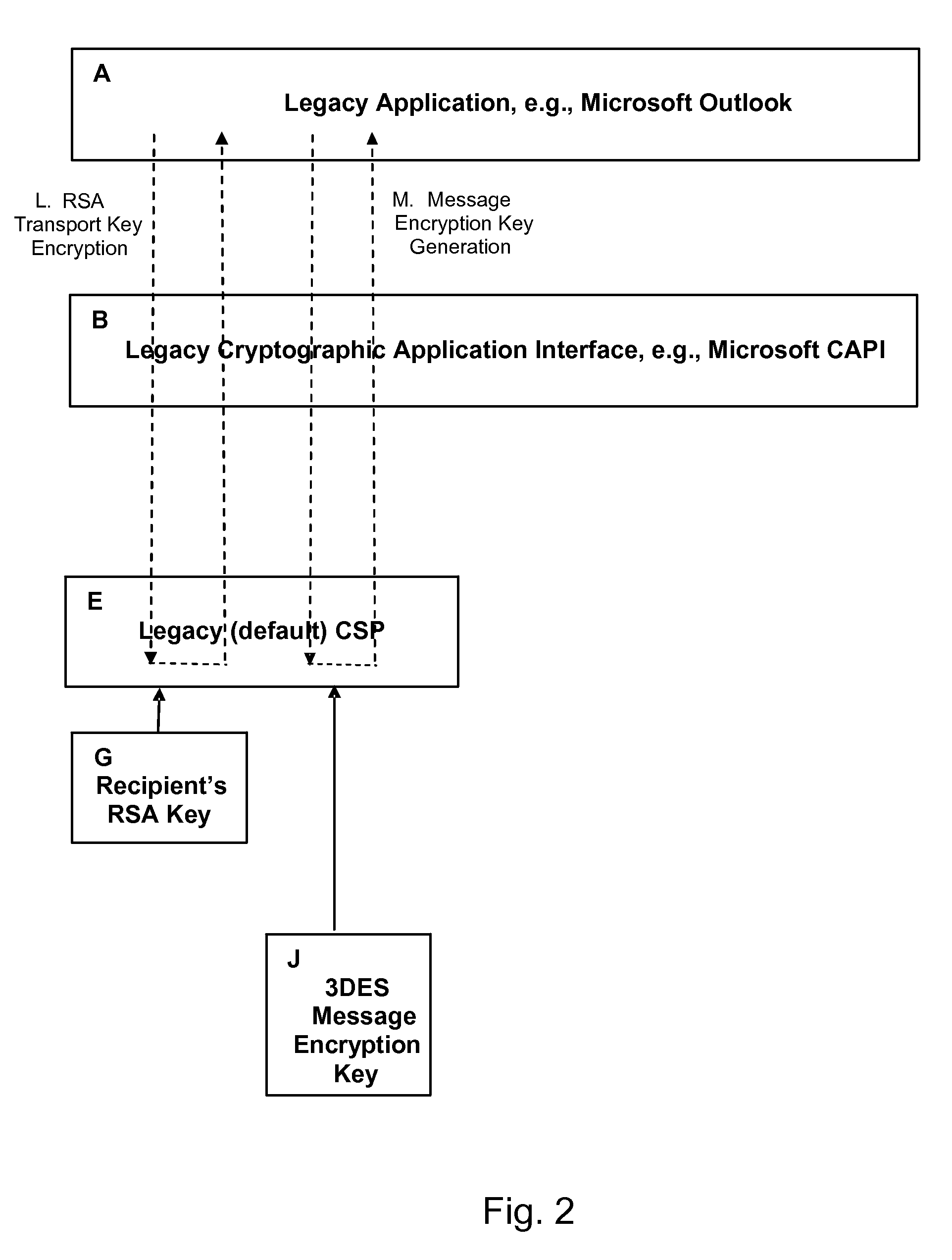Legacy cryptographic algorithms and protocols developed over 30 years ago, e.g., triple-DES, RSA, and SHA-1, are becoming obsolete and are at risk of being compromised or “broken” in the relatively near future.
However, directly incorporating these advanced algorithms within existing operating systems and / or cryptographic applications would require extensive rewrites at a significant cost and with a substantial
delay in widespread availability to take
advantage of them.
In addition, the introduction of such advanced algorithms cannot be accomplished with the flick of a switch, but instead must be phased in over time.
In general, this phased introduction will give rise to serious
interoperability problems, with a portion of the
community not being able to communicate with others until the conversion has been completed.
Such approaches have not adequately addressed the introduction and support of new
encryption / decryption and
digital signature cryptographic algorithms that coexist with and interoperate in concert with older legacy algorithms at the time the encrypted and / or digitally signed data is first created.
This
encryption algorithm conversion method requires three-party communications and associated delays and service costs to substitute one set of cryptographic algorithms for another.
This art does not address the coexistence of mixed
digital signature and
encryption algorithm environments such as in e-mail, messaging, and collaborative
business transactions where the senders and receivers have not previously been known to each other nor agreed to maintain a shared user identification
database, or where advanced knowledge of their cryptographic algorithms is not known.
Such art does not address issues of providing user transparency for digital signature and encryption applications using both legacy and upgraded cryptographic methods in interactive communications among groups of senders and receivers.
This form of art does not address interactive communications among impromptu groups of senders and receivers or user transparency of operations for digitally signed and / or encrypted messages using both legacy and upgraded cryptographic algorithms in open network environments.
In other existent methods for achieving cryptographic algorithm
interoperability between senders and receivers, Secure Sockets Layer (SSL) and similar protocols permit the negotiation of the cryptographic algorithms and key lengths to be used, based on the capabilities of the
client and the
server, on a one-to-one basis, but this is limited to
transmission security between the nodes for each
single session, and not to the contents communicated through an end-to-end store-and-forward communication
system.
Such art does not apply to more general packet communications networking supported by
the Internet and other network architectures, nor does it address
interoperability with coexistent legacy and advanced digital signature algorithms.
Such a solution does not provide for gradual adoption of improved encryption security methods through transparent interoperability among individuals or ad hoc groups of senders and recipients of both legacy and advanced encrypted communications through the use of dual key certificates whereby one of a set of simultaneously available encryption algorithms can be chosen for decryption based on the capabilities and standards supported by each individual recipient's computer.
Prior art does not address methods and apparatus to enable transparent interoperability of digital signature applications using both legacy and improved cryptographic algorithms through means to automatically choose one of a number of simultaneously operable different signing algorithms for communications among communities of users each of whose computer facilities and
software only support one of the sets of algorithms.
One of the primary impediments to the widespread adoption and use of
Elliptic Curve Cryptography (ECC) is the lack of availability of ECC certificates, and in particular an ECC key that is embedded within a
certificate that is signed using RSA, e.g., using an appropriate self-signed root key and
certificate.
Although it would be possible to set up a parallel hierarchy of RSA and ECC root certificates and cross-certify them, this additional complexity is in itself an impediment to timely adoption.
Unfortunately, it currently appears that this capability is probably not going to be available until the
Windows Server (codenamed “Longhorn”) becomes available, which may not be until 2008 or 2009, and is not likely to be widely deployed for several more years after that.
At present, it does not seem likely that other ECC-enabled CA products and services will be available from other vendors or
trusted third party providers any sooner than that.
In addition, even if some other Certification Authority were able to issue ECC certificates, it would still be a problem to get popular
client operating systems and applications, e.g.,
Microsoft Windows XP and Office 2003, as well as other operating systems and applications such as Linux, Solaris, and others, to process those keys and certificates properly, at least until new operating systems and / or new service packs are released for existing systems to solve the problem.
Because the support for the advanced algorithms may be considered an important
differentiator and a motivating force to persuade users to
upgrade to the latest version of the product, vendors may be reluctant to retrofit their older systems with the new technology.
However, many
certificate-
processing systems do not process the Critical bit properly, and that might lead to undesirable interoperability problems.
2. One preferred method would include an ECC public key within the “standard” X.509 certificate, as an ECDSA-signed certificate attribute extension, in addition to an RSA key that would be represented normally. With this scheme, the ECC key would be ignored by relying party
software that didn't understand the attribute, while the ECC key would be validated only against an ECC chain of signatures, ignoring the RSA chain entirely. This would become a double-use certificate—most users would see and recognize only the RSA key, whereas those with the appropriate
software would see the digitally signed ECC key within the certificate hierarchy. However, this approach cannot bind the rest of the content of the certificate including the user's Distinguished Name to the ECC key without a substantial reworking of the standard certificate
processing mechanisms within the
Certificate Authority program.
3. A certificate request could be generated containing both an RSA and an ECC public key, and sent to the
Certificate Authority to be signed. After the signed certificate was generated, thereby proving that the identity of the user had been properly established, another process, e.g., the SPYRUS
Signal Identity Manager
Registration Authority, could operate as a “certificate creation utility” or a “shadow CA” to create a substitute ECC certificate, relying on the previously created RSA certificate as its authority to do so. The ECC certificate could make use of the same issuer name and serial number, so that revoking the RSA certificate (with a
Certificate Revocation List (CRL) or
Online Certificate Status protocol (OCSP)) would have the same effect as revoking the ECC certificate, and vice versa. Unfortunately, although this approach solves the problem of creating an ECC certificate, it does little to solve the certificate validation problem within legacy operating systems and applications.
 Login to View More
Login to View More  Login to View More
Login to View More 


